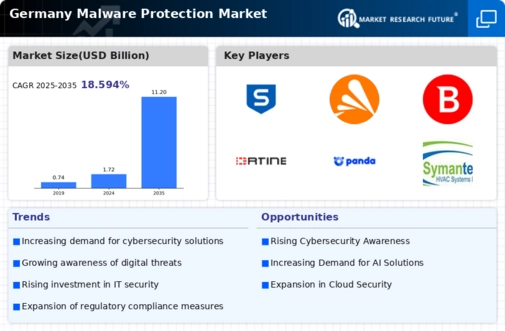Rising Cyber Threats
The malware protection market in Germany is experiencing growth due to the increasing frequency and sophistication of cyber threats. Reports indicate that cybercrime costs the German economy approximately €100 billion annually, highlighting the urgent need for robust malware protection solutions. As businesses and individuals face a growing array of malware attacks, including ransomware and phishing schemes, the demand for effective cybersecurity measures intensifies. This trend is further supported by the fact that 70% of German companies have reported experiencing at least one cyber incident in the past year. Consequently, organizations are prioritizing investments in malware protection technologies to safeguard their digital assets and maintain operational integrity. The rising cyber threats thus serve as a significant driver for the malware protection market, compelling stakeholders to seek advanced solutions that can mitigate risks and enhance security postures.
Increased Digital Transformation
The ongoing digital transformation across various sectors in Germany is a key driver for the malware protection market. As organizations increasingly adopt cloud computing, IoT devices, and remote work solutions, the attack surface for cybercriminals expands. A survey indicates that 60% of German businesses have accelerated their digital initiatives, leading to a heightened focus on cybersecurity. This shift necessitates the implementation of comprehensive malware protection strategies to address vulnerabilities associated with new technologies. Moreover, the integration of digital tools in everyday operations has made it imperative for companies to protect sensitive data from potential breaches. The malware protection market is thus poised for growth as businesses recognize the importance of securing their digital environments against evolving threats, ensuring compliance with data protection regulations, and maintaining customer trust.
Regulatory Frameworks and Compliance
The regulatory landscape in Germany plays a crucial role in shaping the malware protection market. With stringent data protection laws, such as the General Data Protection Regulation (GDPR), organizations are compelled to implement robust cybersecurity measures to ensure compliance. Non-compliance can result in hefty fines, reaching up to €20 million or 4% of annual global turnover, whichever is higher. This regulatory pressure drives businesses to invest in effective malware protection solutions to safeguard personal data and avoid legal repercussions. Furthermore, the German Federal Office for Information Security (BSI) provides guidelines and recommendations that further emphasize the importance of cybersecurity. As companies strive to meet these regulatory requirements, the malware protection market is likely to see sustained growth, as organizations seek to align their security practices with legal obligations and industry standards.
Growing Awareness of Cybersecurity Risks
In Germany, there is a notable increase in awareness regarding cybersecurity risks among businesses and consumers alike. Educational initiatives and high-profile cyber incidents have contributed to a heightened understanding of the potential consequences of inadequate malware protection. As a result, organizations are more inclined to invest in cybersecurity solutions, with the malware protection market witnessing a surge in demand. Recent studies suggest that 80% of German companies are now prioritizing cybersecurity in their strategic planning, reflecting a cultural shift towards proactive risk management. This growing awareness not only drives investments in malware protection technologies but also encourages collaboration between public and private sectors to enhance overall cybersecurity resilience. Consequently, the malware protection market is likely to benefit from this increased focus on risk mitigation and the establishment of a more secure digital landscape.
Technological Advancements in Cybersecurity
Technological advancements are significantly influencing the malware protection market in Germany. Innovations in artificial intelligence, machine learning, and behavioral analytics are enhancing the capabilities of malware protection solutions. These technologies enable organizations to detect and respond to threats more effectively, reducing the time to mitigate potential breaches. As a result, the malware protection market is witnessing a shift towards more sophisticated solutions that leverage these advancements. Reports indicate that the adoption of AI-driven security tools is expected to grow by 30% in the coming years, reflecting the increasing reliance on technology to combat cyber threats. Additionally, the integration of automation in malware protection processes allows for more efficient threat management, further driving market growth. Consequently, the continuous evolution of technology serves as a vital driver for the malware protection market, as organizations seek to stay ahead of emerging threats and enhance their security frameworks.
























Leave a Comment